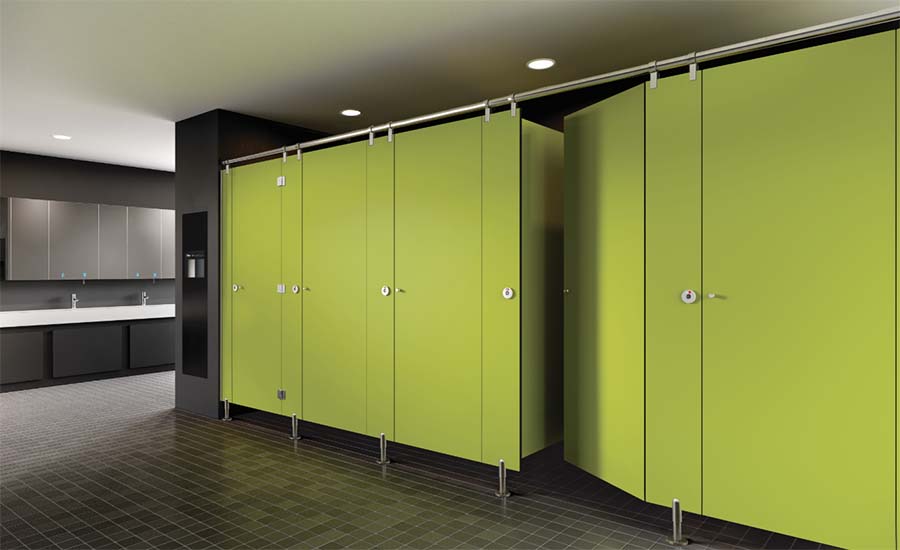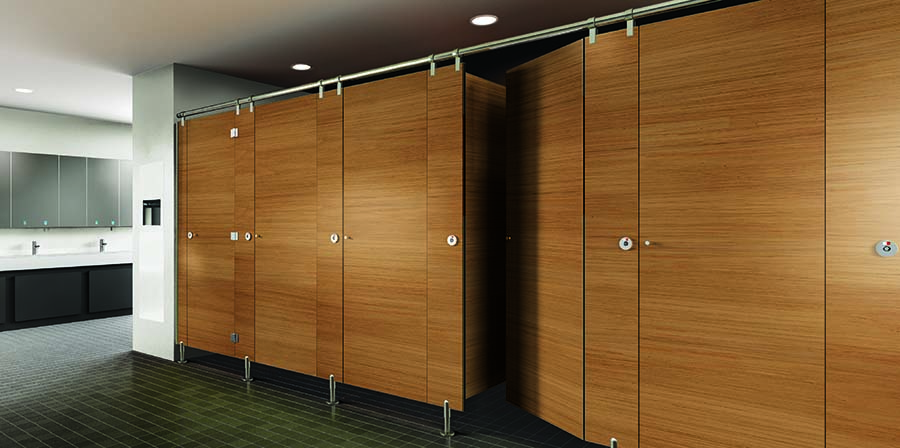As one of the most central elements in making a patron, customer, or even an employee, feel valued, bathrooms need to exhibit the same type of thoughtfulness given to every other aspect of the human experience in a building.

Picture in your mind’s eye the virgin flight of a newly designed 300-passenger aircraft, equipped with the latest jet engines, soaring over the Swiss Alps. Next, close your eyes and try to imagine that same aircraft, equipped instead with twin propeller engines, designed by the Wright Brothers for their virgin flight in 1903.
Now, transpose that imagination to the built environment even as we embark on a journey that has an entirely new paradigm. Undoubtedly design elements that have worked in the past will need to be altered and standards that we have taken for granted will need to be revisited. We have a heightened focus on the need for sterile and safe environments, and we must find a way to weave that into the delicate balance that has been achieved between aesthetics, functionality, sustainability, efficiency, and productivity. There is a new and elevated baseline for design, and the metrics we have used to judge success are being re-written.
But let’s take a step back. Even before we were faced with the fragility we feel today, the basis for design in every project has always been the human experience. The best buildings have always been ones where every aspect of the structure is in simpatico with the other. Every design element is integrated with, and accentuates, the other. The energy efficiency of the building envelope adds to the beauty of the facade. The inviting yet secure entrance leads to the fluidity and safety of the interior spaces. And the deliberate design that goes into the other parts of the building carries through to the bathrooms— because bathrooms are critical to the human experience. For occupants that interact with a building on a daily basis, the bathroom is often the most used room in a building, and it can become the cornerstone for how the entire building is perceived.
Architecture is more than memorable structures, beautiful entryways, and well-appointed landscapes. Architecture is about form meeting function in a way that both exist in a delicate balance that does not overpower the other.
Quantifying the bathroom experience— the effect of great bathroom design on a building’s reputation.
Our built-in need for privacy is laid bare in public bathrooms, most of which are designed for multiple users and simultaneous use. This can cause public bathrooms to bring out deep-rooted fears, which may manifest in a visceral response. While some people may be mildly bothered by the thought of using a public washroom, others are paralyzed by the prospect—to the point that they cannot use the washroom while it is occupied by others.
In the restaurant or retail industry the “bathroom experience” can be the difference between whether first-time customers return or take their business elsewhere. So bathrooms designed to optimize the user experience can be the difference maker to the building owner who wants to rent space, the retailer who wants customers to return, or businesses who want their employees to feel valued. In the March 8, 2016, edition Work Design Magazine stated, “It will come as little surprise that thoughtful attention to the design and management of restrooms is more significant than often recognized. It offers the ultimate opportunity for employers and office managers to ‘walk the talk’ of a high-performance work environment.”

Keeping this in mind, Leon Shakeshaft, architect and partner, Arthur Gibney & Partners, Dublin, Ireland, notes, “At our firm, we recognize that all things being equal, the quality of bathrooms can be the differentiating factor when our clients seek to attract tenants. Good bathroom design does not have to cost more, but it pays great dividends.”
One-hundred percent of the opinion of the building can be affected by less than 1% of the cost of the building—and that is about what a bathroom costs.
Choice Matters:
Imagine you are celebrating a beachside New Year’s Eve on the Caribbean island of Saint Martin; or maybe you are celebrating at campsite in beautiful snowy Halifax, Nova Scotia. Even though it is winter in both locations at that time of year and both are approximately on the same longitude, 63o W, you wouldn’t wear the same clothing in both places, and you wouldn’t shop for the Halifax scenario at a store that only sells beachwear.
Similarly, every building has a unique use type, and even different sections within the same building should be viewed through a different lens as it relates to the types of products and materials in bathrooms. So when shopping for washroom accessories, toilet partitions, or even lockers, one of the top criteria when choosing a manufacturer, should be determining whether or not they have every type of material and product in their category, so that you have a full suite of options with which create your vision. Choice matters—make sure you have plenty of it.
Great Bathrooms: a universal design checklist
Let’s briefly go through a checklist to help you create a space that is both aesthetically pleasing as well as functionally appropriate. Below are some of the key elements that constitute good bathroom design, and we will explore how they intertwine with each.
Privacy:
This is not an optional attribute. Fortunately, privacy can be ensured with good design and proper installation. However, uneven floors or changes in wall dimensions during construction can cause gaps between the doors and pilasters, and can even cause locking mechanisms to get compromised if the stalls are installed askew. If there is concern of that happening, a good option would be to specify European-style partitions that are defined by extra height on both doors and panels, adjustable pedestals to accommodate for uneven floors, superior hardware, and routed edges at sightlines between doors and pilasters that eliminate visibility into the stalls.
Safety:
Mitigating safety risks from hazards, such as wet floors, are a function of good design. One tip is to create an optimal ratio between sinks and the number of drying stations, as well as their location, to reduce the chances of water from dripping hands ending up on the floor.
Codes:
Accessibility: Ensuring accessibility for people with every type of physical ability is fundamental. It is important to have a complete understanding of the intent of ADA codes that address issues like circulation path, maneuverability, clear floor space, reach ranges, mirror mounting height, and even door swings among others. If manufacturers of washroom accessories and partitions don’t have the experience or bandwidth to meet unique needs, specifying products that adhere to local laws can be a challenge. Careful consideration of product choice will create a safe space or everyone.
Fire standards: There are two standard test methods used to measure level of fire safety of interior finishes. The first, ASTM E-84, tests the surface burning characteristics of building materials using a tunnel test method. The other standard is a rigorous room corner test, performed in accordance with NFPA 286, which measures the contribution of interior finish materials to room fire growth during specified fire exposure conditions. Make sure that you use the most stringent testing methods to meet the highest standard of fire safety.
Maintenance, Sustainability, and Product Lifecycle:
Sustainability is not about accumulating enough points to get a gold or silver LEED certification alone. A sustainable washroom has a design professional behind it who has thoughtfully planned a maintainable, durable design with an eye toward initial and total lifecycle cost. This bathroom will have a pleasing aesthetics and will also be able to withstand predicted use and required maintenance. Proper material choice and use-based product selection will play a big role in ensuring that products don’t meet a premature end of life in a land fill. In addition, design professionals must become familiar with maintenance procedures and materials if they are to protect their designs and create truly sustainable projects—this forward thinking helps guarantee the longest possible lifecycle for each component.
Toilet partitions material and style choices:
Partitions make one of the biggest visual and material impacts in the bathroom simply because they take up a lot of the real estate. There are a number of material options: powder coated, stainless steel, solid plastic, plastic laminate, and phenolic. Each has its strengths and weaknesses, and each fulfills a specific task in different bathrooms. The way partitions are mounted can also impact the ease of maintenance and the types of cleaning products one can use. Seeking a source that offers multiple material and construction options will give architects a complete palette to choose from.
Washroom accessories:
Washroom accessories are sometimes viewed as minor, and choices may even be left to a building manager. An important decision is good material choice—specifying washroom accessories only made of type 304 stainless steel, the standard for the washroom industry, will go a long way in sustainability. Free plastic dispensers or even low-grade dispensing systems offered by some consumable companies, like paper towel or soap suppliers, take away from the overall design intent of the architect. This can lead to mismatched selections, a misalignment of aesthetics, and it can end up costing the building owner more than if these selections were made by the design team. Getting locked into a contract with a specific brand of consumables that use a free but proprietary dispenser can cause the building owner to be at the mercy of the manufacturer’s supply chain—and we have learned that to be daunting during the upheaval cause by the pandemic of 2020.
Hand Washing and Drying:
One of the challenges for any facility management team is having enough consumables, particularly during high-volume events—that includes keeping soap dispensers filled. Specifying top fill, multi-feed systems can make maintenance fast and cost effective—creating a better occupant experience. Waste receptacles with the appropriate capacity can make a big difference in improving hygiene at a stadium or even in an airport.
There has been an ongoing debate as to the best choice for drying hands: paper towels or hand dryers. If you speak with a manufacturer that only makes hand dryers, they may never guide you to install a paper towel dispenser even if that may be the better option in a particular use-case. In speaking with a manufacturer of only paper consumables, you may get an opposite, but equally adulterated, opinion. While the debate may be worth having, choosing a manufacturer that offers both hand dryers and paper towel dispensers will ensure that you get unbiased guidance from your manufacturer’s representative.
Allowing for diversity of use and population:
High-frequency or high-demand facilities, like stadiums, must be designed with high-capacity dispensers and waste receptacles to create a fluid path of travel through the bathroom and to alleviate long lines. Stadium owners, public or municipal, will face a negative financial impact as a patron’s time is wasted in bathroom line, rather than being used to spend money at the checkout line at a concession stand or in a merchandise store.
Public bathrooms must cater to the varied needs of people from different cultures or walks of life. Accommodating people with heightened needs for privacy or accessibility is important. Having the appropriate products to attract customers is also important—for example, a shopping mall that has plenty of diaper changing stations in both the men’s and women’s bathrooms will undoubtedly attract more families that are in the high-spender demographic.
A paradigm shift in bathroom design.
You must have noticed that we left out discussing hygiene earlier. As this is being written the topics foremost on everyone’s mind is hygiene, social distancing, and infection mitigation. The CDC recommends washing hands frequently if we are in a public space, or after sneezing, coughing, or blowing your nose. Our overall hygiene has been left wanting and new solutions and designs are needed.
Thankfully, architects are often inspired to come up with fresh ideas during the midst of a crises—and there is not a much bigger one we have faced in our lifetime.
But there are more questions today than answers. Will changes be legislative, or market driven? How do we separate people while still allowing them to meet their fundamental need to be social? Can we expect more pandemics in the future or was this a once-in-a-hundred-year event?
- Regardless of the specific questions, one can imagine that public spaces will be designed for minimum human contact, with more automation and touch free experiences actuated by voice command.
- Future designs may need to develop multipurpose, adaptable buildings, with built-in flexibility which would allow segments of a building to morph into use for different scenarios. There will be a move to retrofitting existing buildings so that areas of a building can be segregated to restrain the movement of people between departments.
- Public bathrooms where standard doors were once the norm will be altered wherever possible to eliminate the doors and create S-curve entrances.
- Hands-free technology in bathrooms will become the norm. Where there is inevitable contact with surfaces, designers will increasingly look out for antimicrobial products coatings and materials to frequently touched surfaces like doorknobs.
- There will be far more opportunities for hand washing and sanitizing and an addition of mobile sanitizer stations.
- While in the past a building may have had a main entrance there will likely be multiple public entrances, along with the need for public bathrooms near each of those entrances.
- Building owners who add hygienic vending machines, or even well-designed dispensers for sanitizing wipes and liquids will encourage employees to clean their own spaces more frequently.
As building owners decide to install these dispensers, careful consideration should be given to whether those dispensers can dispense multiple brands’ consumables so that they are not locked into the supply chain limitations of only one brand.
Finally as buildings and spaces become more multipurpose, people will have to become more nimble and will have to develop the flexibility to work in a state of flux from time to time.
Navigating the Future:
Cyrus Boatwalla, director of marketing, ASI Group, notes, “In the construction industry we need to plan for future Black Swan events—not just COVID-19. If we only plan to combat the types of pandemic we are facing now, we will be fighting a war based on yesterday’s experience. As our planet gets more populated and as we face the potential of harsher weather, we must build to a variety of different potential threats. Now is the time to take the blinders off, to use an old cliché, and to think of things we never thought of before or to anticipate events we thought would “never happen in my lifetime.” Work with forward-thinking product manufacturers who will offer you a more complete pallet of products to choose from as you design our future.”
So How Do We move forward?
Future innovation will come from collaboration between architects, building product manufacturers, building owners, tenants, and government. Leaving any party out will not provide the optimal results.
- Seek out trustworthy manufacturers’ representatives and rely on their expertise.
- Work with products designed to complement each other in order to design a more cohesive space.
- Throw away outdated standards and specs. Recycling old specs does not constitute sustainability. Shortfalls in design often occur when designers operate from a series of specifications that were either adopted from previous projects or are a part of an outdated master specification.
- Take off all blinders and pursue avenues you may not have considered before.
A 2011 study by John Goins, Center for the Built Environment, University of California, Berkeley, and Mithra Moezzi, Portland State University, shows that the organization that provides a bathroom that is thoughtfully designed and features materials that wear well will be more positively evaluated than those that don’t.
A well-designed bathroom can be the deciding factor in elevating a building from good to great. Bathrooms, if given the requisite attention to detail, can make a much greater positive impact on the user experience of a building—thus influencing their opinion of the school, the town, the business, the building owner, and the architects who designed the building. Protect your reputation.
Buildings of the future deserve, even demand, future oriented bathroom design.

Cyrus Boatwalla, of the ASI Group, has over 20 years of executive experience, leading businesses with varied brand portfolios in roles such as Divisional GM / Head of Operations & Head of Global Marketing.
He has built Consumer Facing and B2B brands for Fortune 500, as well as private companies.

